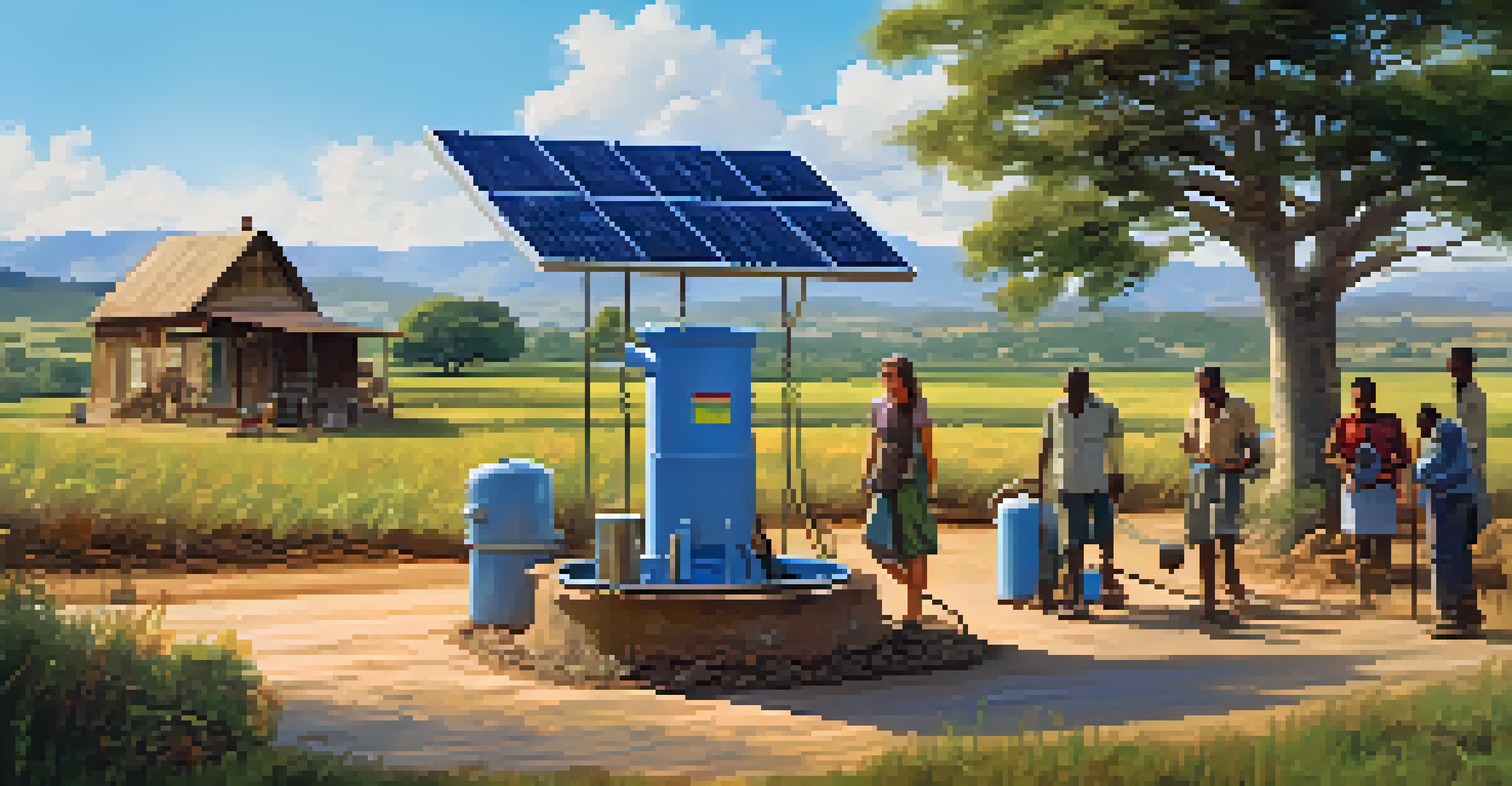Access to Clean Water: A Global Health Equity Challenge

Understanding the Importance of Clean Water Access
Clean water is essential for life, impacting everything from health to economic stability. Without access to safe drinking water, communities face increased risks of waterborne diseases, which can lead to severe health complications. Imagine trying to quench your thirst with contaminated water; it's a daily reality for millions.
Water is the driving force of all nature.
Moreover, access to clean water is intertwined with education and gender equity. In many regions, women and children bear the burden of fetching water, often requiring hours each day that could be spent studying or working. This cycle of inconvenience and danger perpetuates poverty and limits opportunities for advancement.
Ultimately, clean water is not just a resource; it’s a fundamental human right. Ensuring equitable access can lead to healthier populations and more prosperous communities. It's a crucial step toward achieving broader health equity on a global scale.
Current Global Water Access Statistics
As of recent reports, approximately 2 billion people lack access to safely managed drinking water services. This staggering number highlights the urgent need for systemic change. Countries in regions like Sub-Saharan Africa and South Asia are particularly affected, with many facing dire shortages.

Statistics also show that the lack of clean water contributes to the deaths of nearly 2 million children annually due to preventable diseases. This is not just a number; it represents lives lost and potential unrealized. Every statistic tells a story of struggle, resilience, and the urgent need for action.
Clean Water is a Human Right
Access to clean water is essential for health, education, and economic stability, highlighting its importance as a fundamental human right.
In contrast, wealthier nations often take clean water for granted, with robust infrastructure supporting easy access. This disparity underscores the global challenge of health equity; while some enjoy abundance, many are left to cope with scarcity. Bridging this gap is essential for a healthier future for all.
Barriers to Clean Water Access
Several barriers prevent equitable access to clean water, including infrastructure deficits, political instability, and economic challenges. In many developing countries, outdated or insufficient plumbing systems lead to contamination and scarcity. It’s like trying to fill a glass with a leaky faucet—no matter how much you want it, you can’t get what you need.
The health of our waters is the principle measure of how we live on the land.
Additionally, climate change exacerbates water access issues, leading to droughts and unpredictable rainfall patterns. Regions that once thrived on reliable water sources now find themselves in crisis mode, further stressing already vulnerable communities. This creates a vicious cycle where the most affected populations are also the least equipped to adapt.
Social factors, such as discrimination and poverty, also play a significant role. Marginalized communities often face the greatest challenges in obtaining clean water, compounding existing inequalities. Addressing these barriers requires a multifaceted approach that considers both environmental and social dimensions.
The Role of Global Organizations in Water Access
Global organizations like the United Nations and World Health Organization play crucial roles in addressing water access disparities. Through initiatives and partnerships, they aim to promote safe drinking water and sanitation worldwide. Their efforts often focus on sustainable solutions that can be maintained long-term.
Programs that provide funding, education, and technology to underserved areas have shown promise. For instance, initiatives that install solar-powered water pumps can revolutionize access in remote regions. These organizations work tirelessly to ensure that communities are not just provided with resources, but also the knowledge to sustain them.
Global Disparities in Water Access
Nearly 2 billion people lack access to safe drinking water, with stark contrasts between wealthier nations and those facing severe shortages.
However, the effectiveness of these efforts often hinges on cooperation between governments, NGOs, and local communities. Building trust and fostering collaboration can lead to greater success in implementing lasting solutions. It’s a reminder that solving global challenges requires a united front and shared commitment.
Innovative Solutions for Water Accessibility
Innovation is key to overcoming the challenges of water access. From advanced filtration systems to rainwater harvesting technologies, creative solutions are emerging around the globe. For example, some communities are using bio-sand filters to purify water efficiently and affordably.
Mobile applications are also being developed to help communities locate the nearest clean water sources. These tools empower individuals by providing real-time information and resources. Imagine having an app that tells you where to find safe drinking water in a pinch—technology can be a game-changer.
Additionally, community-led initiatives often yield successful results, as locals understand their needs best. Empowering residents to take charge of their water resources fosters ownership and sustainability. This grassroots approach can be a powerful catalyst for positive change.
The Importance of Sustainable Practices
Sustainability is crucial when discussing water access. Over-extraction of water resources can lead to depletion and degradation of ecosystems, which ultimately harms communities. It’s essential to find a balance between human needs and environmental health.
Practices such as rainwater harvesting, groundwater recharge, and integrated watershed management are vital strategies. These methods not only ensure consistent water supply but also promote ecological balance. Think of it as nurturing a garden; the more care you give, the more it flourishes.
Innovative Solutions are Vital
Creative technologies and community-led initiatives are key to overcoming barriers and ensuring sustainable access to clean water.
Furthermore, educating communities about sustainable practices can lead to long-term benefits. By fostering a culture of conservation, we can ensure that future generations have access to clean water. Ultimately, sustainability is about creating a legacy of health and abundance.
Advocacy and Community Involvement in Water Access
Advocacy plays a significant role in improving access to clean water. By raising awareness and mobilizing support, individuals and organizations can influence policies that prioritize water access. Grassroots movements have proven effective in pushing for change at local and national levels.
Community involvement is equally important. When local voices are heard, solutions are more likely to be relevant and effective. Programs that engage residents in decision-making processes often see higher success rates, as they address the specific needs of the community.

Encouraging people to take action—whether through volunteering, fundraising, or educating others—can create a ripple effect. Each small effort contributes to a larger movement toward health equity. Together, we can advocate for a world where clean water is accessible to all.